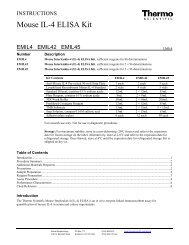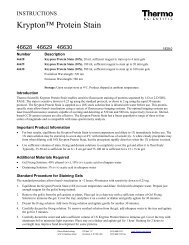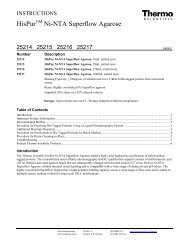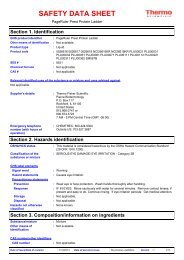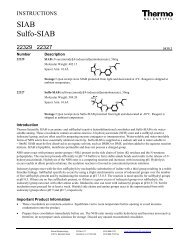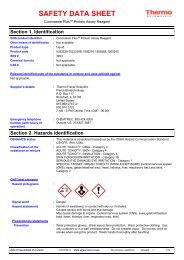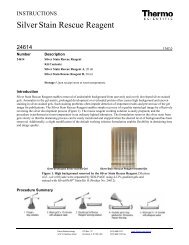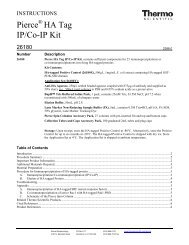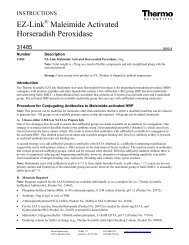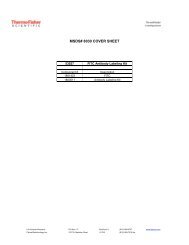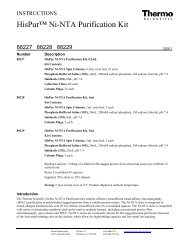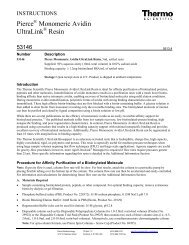Thermo Scientific Pierce Protein Assay Technical Handbook Version 2
Thermo Scientific Pierce Protein Assay Technical Handbook Version 2
Thermo Scientific Pierce Protein Assay Technical Handbook Version 2
Create successful ePaper yourself
Turn your PDF publications into a flip-book with our unique Google optimized e-Paper software.
Total <strong>Protein</strong> <strong>Assay</strong>s<br />
For each of the six methods presented here, a group of 14 proteins<br />
was assayed using the standard protocol in a single run. The<br />
net (blank corrected) average absorbance for each protein was<br />
calculated. The net absorbance for each protein is expressed as<br />
a ratio to the net absorbance for BSA. If a protein has a ratio of<br />
0.80, it means that the protein produces 80% of the color obtained<br />
for an equivalent mass of BSA. All of the proteins tested using the<br />
standard tube protocol with the BCA <strong>Protein</strong> <strong>Assay</strong>, the Modified<br />
Lowry <strong>Protein</strong> <strong>Assay</strong>, the Coomassie (Bradford) <strong>Assay</strong> and the<br />
Coomassie Plus (Bradford) <strong>Assay</strong> were at a concentration of<br />
1,000µg/mL.<br />
Compatible and Incompatible Substances<br />
An extensive list of substances that have been tested for<br />
compatibility with each protein assay reagent can be found in<br />
the instruction booklet that accompanies each assay product.<br />
A copy can also be obtained from our web site.<br />
In summary, the Coomassie (Bradford) and the Coomassie Plus<br />
(Bradford) <strong>Assay</strong>s will tolerate the presence of most buffer salts,<br />
reducing substances and chelating agents, but they will not<br />
tolerate the presence of detergents (except in very low concentrations)<br />
in the sample. Strong acids or bases, and even some<br />
strong buffers, may interfere if they alter the pH of the reagent.<br />
The Modified Lowry <strong>Protein</strong> <strong>Assay</strong> is sensitive to the presence of<br />
reducing substances, chelating agents and strong acids or strong<br />
bases in the sample. In addition, the reagent will be precipitated<br />
by the presence of detergents and potassium ions in the sample.<br />
The BCA <strong>Protein</strong> <strong>Assay</strong> is tolerant of most detergents but is sensitive<br />
to the presence of reducing substances, chelating agents and<br />
strong acids or strong bases in the sample. In general, the Micro<br />
BCA <strong>Protein</strong> <strong>Assay</strong> is more sensitive to the same substances that<br />
interfere with the BCA <strong>Protein</strong> <strong>Assay</strong> because less dilution of the<br />
sample is used.<br />
Table 2. <strong>Protein</strong>:protein variation.<br />
<strong>Pierce</strong> 660nm<br />
<strong>Assay</strong><br />
Ratio<br />
BCA<br />
Ratio<br />
Micro<br />
BCA<br />
Ratio<br />
Modified<br />
Lowry<br />
Ratio<br />
Coomassie<br />
(Bradford)<br />
Ratio<br />
Coomassie<br />
Plus<br />
Ratio<br />
Bio-Rad<br />
(Bradford)<br />
Ratio<br />
1. Albumin, bovine serum 1.00 1.00 1.00 1.00 1.00 1.0 1.00<br />
2. Aldolase, rabbit muscle 0.83 0.85 0.80 0.76 0.76 0.74 0.97<br />
3. a-Chymotrypsinogen x 1.14 0.99 0.48 0.48 0.52 0.41<br />
4. Cytochrome C, horse heart 1.22 0.83 1.11 1.07 1.07 1.03 0.48<br />
5. Gamma Globulin, bovine 0.51 1.11 0.95 0.56 0.56 0.58 0.58<br />
6. IgG, bovine x 1.21 1.12 0.58 0.58 0.63 0.65<br />
7. IgG, human 0.57 1.09 1.03 0.63 0.63 0.66 0.70<br />
8. IgG, mouse 0.48 1.18 1.23 0.59 0.59 0.62 0.60<br />
9. IgG, rabbit 0.38 1.12 1.12 0.37 0.37 0.43 0.53<br />
10. IgG, sheep x 1.17 1.14 0.53 0.53 0.57 0.53<br />
11. Insulin, bov. pancreas 0.81 1.08 1.22 0.60 0.60 0.67 0.14<br />
12. Myoglobin, horse heart 1.18 0.74 0.92 1.09 1.19 1.15 0.89<br />
13. Ovalbumin 0.54 0.93 1.08 0.32 0.32 0.68 0.27<br />
14. Transferrin, human 0.80 0.89 0.98 0.84 0.84 0.90 0.95<br />
Avg. ratio 0.7364 1.02 1.05 0.68 0.68 0.73 0.60<br />
S.D. 0.2725 0.15 0.12 0.26 0.26 0.21 0.28<br />
CV 37% 14.7% 11.4% 38.2% 38.2% 28.8% 46%<br />
1. All of the proteins were tested using the standard tube protocol with the Micro BCA <strong>Protein</strong> <strong>Assay</strong> at a protein concentration of 10µg/mL.<br />
This table is a useful guideline to estimate the protein:protein variation in color response that can be expected with each method. It does<br />
not tell the whole story. However, because the comparisons were made using a single protein concentration, it is not apparent that the<br />
color response ratio also varies with changes in protein concentration.<br />
To order, call 800-874-3723 or 815-968-0747. Outside the United States, contact your local branch office or distributor.<br />
9



